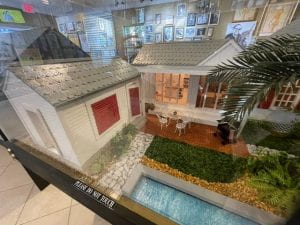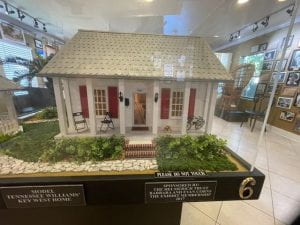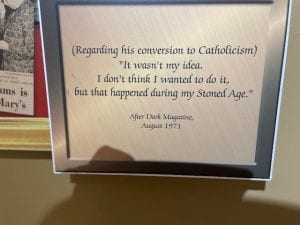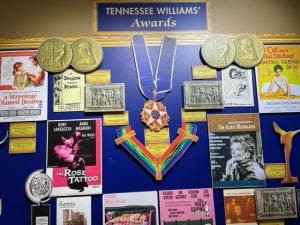Poets.org tells us that Key West was a location for poets in the early twentieth century.
Over 100 miles from mainland Florida and the southernmost point in the United States, Key West has attracted numerous artists and writers, including Ernest Hemingway, Wallace Stevens, Ralph Ellison, Elizabeth Bishop, Tennessee Williams, Robert Frost, and James Merrill, with its remote location, tropical setting, and wild spirit.
Tennesee Williams came to Key West at the age of thirty in 1941. He bought property on 1531 Duncan Street in the neighborhood of the poet Elizabeth Bishop, who lived at 624 White Street.
Unlike the Hemingway House, Tennessee Williams’ place in Key West is owned privately and inaccessible to the public. However a museum dedicated to his memory has a model of the house on Duncan Street (below). It has a back wing he called the “Mad House,” where he wrote so many of his plays. By all accounts he loved Key West and several of his plays were performed in the local Waterfront Theater.
We saw a Christmas play at the Waterfront Theater, All is Calm. It is true story of a truce on Christmas Eve between the Germans and the British in World War II. It is really an opera performed with Christmas carols and popular songs of the period. It begins with tentative overtures to celebrate together and ends with raucous and a little drunken singing, as the soldiers consume what is left of their alcoholic rations. The production is really an homage to “peace on earth” and the hope of reconciliation of traditional adversaries.
Tennessee himself was not a dreamer, but an unapologetic realist. Regarding his late conversion to Catholicism, he said, “It wasn’t my idea. I don’t think I wanted to do it, but that happened during my Stoned Age.” Poets.org confirms that “Williams was baptized, with encouragement from his brother and a fair amount of alcohol, at St. Mary Star of the Sea Catholic Church on Truman Avenue.”
His Pulitzer Prize award-winning dramas were A Streetcar Named Desire and Cat on a Hot Tin Roof, both stories of hard-edged characters, although he said his favorite among his plays was the more sentimental The Glass Menagerie.
According to Poets.org, the nearby neighborhood of Windsor Lane became a gathering place for poets in the mid-twentieth century.
Near Solares Hill, the island’s highest point at sixteen feet above sea level, is Windsor Lane Compound, established in 1976. The assortment of restored shacks, shanties, and cottages, were once winter homes for writers such as Richard Wilbur, John Ciardi, John Hersey, and Ralph Ellison. On William Street is a Greek Revival house and writing studio once owned by Shel Silverstein.
… Another frequent visitor, Wallace Stevens once wrote in a letter that Key West “is the real thing… the sweetest doing nothing contrived.” Though good friends with Hemingway, one rainy night outside of Sloppy Joe’s bar, the two got into an infamous brawl in which Stevens broke his hand on Hemingway’s jaw. https://poets.org/listing/poet-homes-key-west-fl
This is a lot of lore I did not know when we visited Key West, so we missed some of it. We ate twice at the Banana Cafe on Duval Street, which is not too far from Windsor Lane and William Street, but we were unaware. These locations were remote from the wharf and the entertainment district of Key West. They were more bohemian and inexpensive. Wallace Stevens wrote:
Why, when the singing ended and we turned
Toward the town, tell why the glassy lights,
The lights in the fishing boats at anchor there,
As night descended, tilting in the air,
Mastered the night and portioned out the sea,
Fixing emblazoned zones and fiery poles,
Arranging, deepening, enchanting night.





